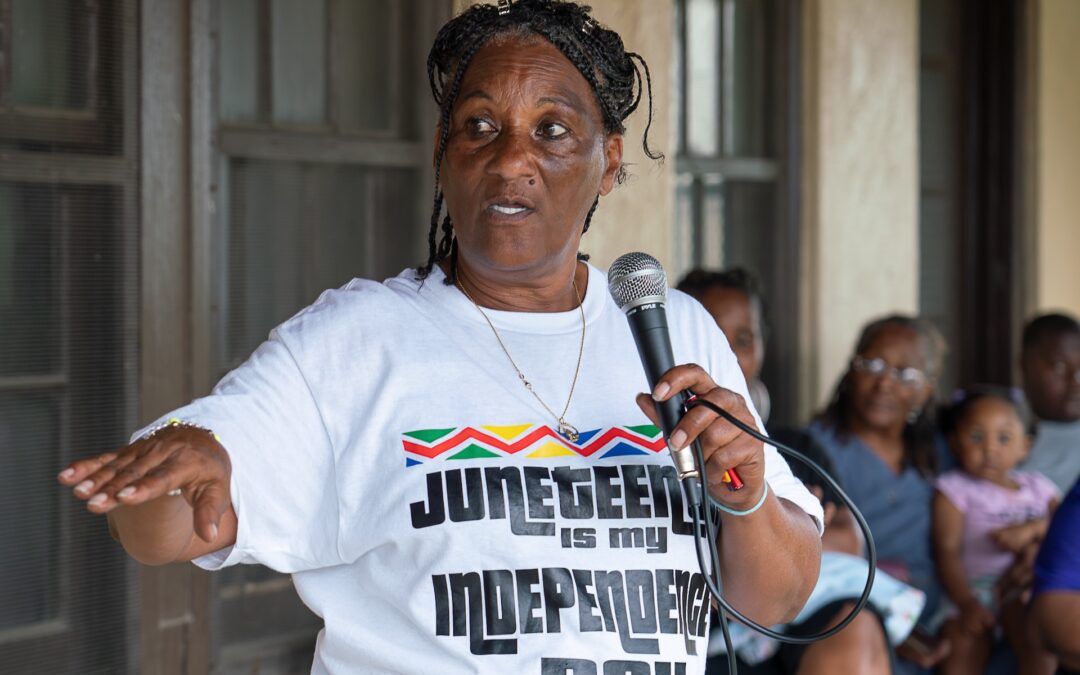Margaret Carter, director of the grassroots nonprofit Where We Thrive, discusses plans to campaign for the re-opening of Northside Pool during a recent Juneteenth celebration at the park. Photo by Ursula Rogers.
The legacy of Northside Pool is a riddle wrapped in secrecy that began in 1873 in Brockton, Massachusetts, with the birth of philanthropist and wildcatter Edgar B. Davis. The facts surrounding Davis’s gift of Northside Pool and Southside Pool to the City of Luling in the late 1920s are convoluted and may sound stranger than fiction. The closing of Northside Pool in 2013, with a lack of transparency from the city, has also been hard to comprehend because the reasoning is tortuous and long-winded as well.
To understand this odyssey, one must pull back the cloak from Luling’s peculiar personality which advocates a white-dominated caste system, in this writer’s opinion. Everyone is born into a certain station and must “stay in your place!”
The city of Luling was named after New York banker Charles Luling, who established it in September 1874 as a railroad town on the road to San Antonio that he was financing for a friend. Luling became a premier stop of the big cattle drives that went up the Chisholm Trail, and because of its rowdiness the town once held the ominous reputation as “the toughest town in Texas.” Then came a quieter time when the population shrank, and the white and Black residents worked the fields (mostly cotton) side by side – until the introduction of oil by the wildcatter Edgar B. Davis.
Edgar Davis and his brother Oscar were in the shoe business, and Davis made his first fortune on a shoe plant in Massachusetts that he sold for $1 million. Around 1904, he suffered from depression, and his therapist recommended that he go on a Mediterranean cruise to relax. There he met an old friend who captivated his interest in the possibilities of the rubber industry. After several years of careful preparation, he embarked on 10 years in the Indonesian rubber trade by planting his first rubber tree. It would become one of thousands. He became quite successful and sold his interest for another fortune of $3.5 million with a desire to retire.
Soon bored, and at the appeal of his brother Oscar to come to Caldwell County and manage some oil leases he had purchased, he came to Luling. First, he bought a small share of his brother’s company, and then, at Oscar’s untimely death, Davis bought the remainder of the leases from his estate and proceeded to drill for oil where all the geologists had said there was none. Six dry holes later and broke, he struck oil on the seventh hole known as Rios #1 in 1922. As the town transitioned from agriculture to oil, the affluent (mostly Anglos) migrated toward Zedler Mill in the southern part of the town, and the Blacks and less affluent were consigned to the “Flats,” or the Northside.
As Davis began his third career as a wildcatter, there were other rumblings above ground as well. The Daughters of the Confederacy were traveling around the country spreading the pseudo-narrative of “The Lost Cause” – that the Civil War was a just, patriotic Confederate campaign not about slavery but about “states rights.” In 1921, they dedicated a Confederate memorial in the county seat of Lockhart. Shortly after that came – according to the Houston Post at the time – the “first instance of a city government formally requesting the Ku Klux Klan to stage a demonstration within their city limits: a resolution passed on December 6, 1921, and signed by Luling Mayor C T Greenwood and City Commissioners W B Walker and Albert Taylor, precipitating a massive march of Klansmen on February 10, 1922.” According to the Luling Signal, there were 10,000 in attendance. There followed another KKK parade sanctioned by the City of Gonzales in April and just one month after Davis’s June 5 strike at Rios #1 a parade was held in San Marcos with 25,000 attendees.
By 1926, Davis had developed an oilfield approximately 12 miles long and 2 miles wide that he sold to the Magnolia Oil Company for $12 million. Davis was a deeply religious man raised by his Calvinist mother to believe in a strict interpretation of the scriptures. Because of this, and his eccentric behavior, he believed in sharing his profits and giving bonuses to his employees. His liberal ideas left him with a desire to share his good fortune with his adopted home of Luling, which he believed God had sent him to rescue from the drudgery of picking cotton by discovering other sources of income. He began a campaign to give back.
First Davis threw a picnic on the shore of the San Marcos River for the citizens of his adopted home, Luling, plus surrounding Caldwell County, Guadalupe County, and Gonzales County, to share with the community that had given him so much. It was estimated that 15,000 to 30,000 people attended. The menu is said to have included 6 tons of beef, 5,000 pounds of mutton, and 2,000 chicken fryers, along with vats of beans and potato salad. There were soft drinks, non-alcoholic beer, ice cream, cigarettes, cigars, and more, but because of social norms – namely segregation – Blacks could not attend. Therefore, Davis threw two parties: one for the whites and one for Blacks.
After the $12 million sale of his interest in the oil business, Davis began an unprecedented era of philanthropy. He created an organization known as The Farm Foundation to teach the community landowners techniques that would help them achieve more profitability, and it still operates today. Also included, among other amenities, was the gift of Southside Park and pool for the whites and the Northside Park and pool for the Blacks. He would have preferred one park to be shared by all, with his progressive ideas, but the standards of the times would not permit it.
Even today in quiet conversations in the “Flats” with residents of Ward 1, the prevailing consensus is the Northside Pool was always a favorite hub of activity used and appreciated in the Black community. For instance, at 89 years old, M.T. Carter remembers hanging out at the clubhouse with his friends and classmates from the Rosenwald School for Blacks. He told this writer, “I didn’t do much swimming, but I remember the lifeguard was a tall Black man everyone called ‘Spoony.’”
Then there is Sandra Ellison, who said she had many memories of hanging out at Northside Pool with her friends. “It was the Spot,” Ellison, now in her 60s, said. She shared with the author one memory she would never forget: When she and three friends were slipping in the pool at night, as she went over the fence she caught her ring finger in the wire and scarred it for life. This author asked Kingsley Green, age 42, if he knew why they closed the pool and his reply was, “I don’t know but I have many childhood memories. I learned to swim there and grew up swimming there and playing with my friends.” This author asked Green if he missed the pool now, and his response was surprising: “I’m not sure if I miss it but I’m grateful for it and having had the experience. I’m thankful to many lifeguards and the Schulers, who took part in my growth as a young swimmer.” Green went on to praise the Schuler family as the caretakers at Northside who made the pool enjoyable while maintaining a safe environment.
The drive to close the Northside Pool began in the new century, toward the end of Otha Wade’s tenure on the city council. Mrs. Ann Wade, the councilman’s widow, says he fought mightily to keep it open. She remembers him shepherding his constituents to council meetings to let their voices be heard. Mrs. Wade says she remembered one large rally in the park to keep the pool open. This writer contacted several of the current council members with no response. On two occasions, this author spoke with the Luling city manager, Mark Mayo, and he shared notes from the council meetings of December 2012 and January 2013.
At the December 2012 meeting, Councilmember John Wells motioned to close the Northside Pool, and the motion was seconded. There were discussions about the pool’s viability, according to notes shared by Mayo, who was not employed in Luling then. There were a variety of economic reasons given, such as the expense of bringing the facility into mandated ADA compliance, the $267 it cost to man the pool every time it opened, and the lack of community use of the facility (it had only made $242 in the 2012 season). The meeting minutes note that Wells stated that by having two pools “we are promoting segregation.” Before a vote was taken to address the supposed segregation concerns – bizarrely, by closing the pool most accessible to the Black community in favor of leaving open the pool primarily used by the white community – the motion was tabled.
At the Luling council meeting of January 2013, Wells again called up the motion to close Northside Pool. There was talk of a survey of surrounding cities showing that none had two pools. The vote was 4 to 1, with the only Black Councilmember, Jackie Campbell, voting against the closure.
Northside Pool is no more; it has been sealed with concrete, and the park has had a massive facelift. As a consolation, one of the short neighborhood streets perpendicular to Trinity was renamed Martin Luther King Jr. It would take Edgar Davis’s reincarnation (in which he believed strongly) for the Northside Pool to return. Some had suggested that this author contact the St. David’s Foundation about repairing or replacing the pool. This writer made several attempts to contact a spokesperson and was referred to their website, stdavidsfoundation.org, which didn’t offer grants for such a project.
Upon speaking with those affected by the pool’s closure, some were complacent and accepted the finality of it with a spirit of “go along to get along.” Some even spoke highly of the new character of the park, with the walking trails, basketball goals, playground, and many amusements for younger kids. Inconsistency heads the list of the constituents of Ward 1’s complaints, along with the manipulations, neglect, and disappointments seen in their eyes and heard in their muffled voices that their gift from Edgar B. Davis would be squandered away and not earnestly protected.
Now begins a phase of reeducation, petitions, and voter registration drives spearheaded by local advocates and leaders like activist and CEO Margaret Carter of Where We Thrive (the author’s sister) to return, rebuild, and replace. Asked about her goal with Northside Pool, her compassionate reply was, “ I am determined to help this community, They deserve a fair shake … We will continue to organize and educate and when our numbers are sufficient, we’ll take our case to City Hall.” Stay tuned …
BY JAMES COFFEE CARTER
Author’s note: This article includes information from the following sources:
1) “Edgar Byram Davis, Luling’s Wildcatter & Philanthropist: ‘The most peculiar angel’ and a man of faith” by John Nova Lomax, Texas Monthly, Aug. 11, 2017,
2) “Edgar B. Davis: Wildcatter Extraordinary” by George Riley Froh, Texas A&M University, 1980
3) Houston Post Special, Feb. 1922
4) Luling Signal, Jan. 1922-Jan. 1923
5) Davis, Edgar Byram, Texas State Historical Association, www.tshaonline.org/home
6) The Luling Foundation:
www.lulingfoundation.org/about-the-foundation/our-history/edgar-b-davis


0 Comments